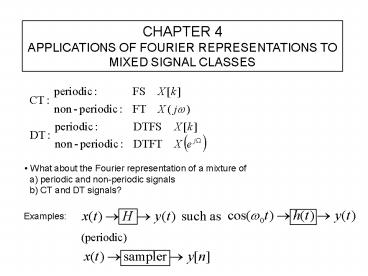APPLICATIONS OF FOURIER REPRESENTATIONS TO - PowerPoint PPT Presentation
Title:
APPLICATIONS OF FOURIER REPRESENTATIONS TO
Description:
What about the Fourier representation of a mixture of. a) periodic and non ... Because h(t) is an ideal bandpass filter with a bandwidth 2p centered at 4p, the ... – PowerPoint PPT presentation
Number of Views:41
Avg rating:3.0/5.0
Title: APPLICATIONS OF FOURIER REPRESENTATIONS TO
1
CHAPTER 4 APPLICATIONS OF FOURIER REPRESENTATIONS
TO MIXED SIGNAL CLASSES
- What about the Fourier representation of a
mixture of - a) periodic and non-periodic signals
- b) CT and DT signals?
Examples
2
- We will go through
- a) FT of periodic signals, which we have used
FS
We can take FT of x(t). b) Convolution and
multiplication with mixture of periodic and
non-periodic signals. c) Fourier transform of
discrete-time signals.
FT of periodic signals
Chapter 3 for CT periodic signals, FS
representations. What happens if we take FT of
periodic signals?
3
FS representation of periodic signal x(t)
Take FT of equation () ?
Note a) FT of a periodic signal is a series of
impulses spaced by the fundamental frequency
w0. b) The k-th impulse has strength 2pXk. c)
FT of x(t)cos(w0t) can be obtained by replacing
4
FS and FT representation of a periodic
continuous-time signal.
5
Example 4.1, p343
E
6
Example 4.2, p344
E
p(t) is periodic with fundamental period T,
fundamental frequency w0. FS coefficients
7
Relating DTFT to DTFS
N-periodic signal xn has DTFS expression
Extending to any interval
This, DTFT of xn given in () is expressed as
8
Since Xk is N periodic and NW02p, we have
- Note
- a) DTFS ? DTFT
- b) DTFT ? DTFS
- Also, replace sum intervals from 0N-1 for DTFS
to -? ? for DTFT
Problem 4.3(c), p347
E
Fundamental period?
9
Use note a) last slide
Question if we take inverse DTFS of Xk, we get
Exercise use Matlab to verify.
10
Convolution and multiplication with mixture of
periodic and non-periodic signals
For periodic inputs
1) Convolution of periodic and non-periodic
signals
11
Problem 4.4(a), p350 LTI system has an impulse
response
E
12
Because h(t) is an ideal bandpass filter with a
bandwidth 2p centered at ?4p, the Fourier
transform of the output signal is thus
which has a time-domain expression given as
For discrete-time signals
13
2) Multiplication of periodic and non-periodic
signals
Carrying out the convolution yields
DT case
E
Problem 4.7, p357(b)
Consider the LTI system and input signal spectrum
X(ejW) depicted by the figure below. Determine an
expression for Y(ejW), the DTFT of the output
yn assuming that zn2cos(pn/2).
14
Thus,
15
E
Example 4.6, p353 AM Radio
(a) Simplified AM radio transmitter
receiver.(b) Spectrum of message signal.
Analyze the system in the frequency domain.
16
Signals in the AM transmitter and receiver. (a)
Transmitted signal r(t) and spectrum R(j?). (b)
Spectrum of q(t) in the receiver. (c) Spectrum
of receiver output y(t).
In the receiver, r(t) is multiplied by the
identical cosine used in the transmitter to
obtain
After low-pass filtering































